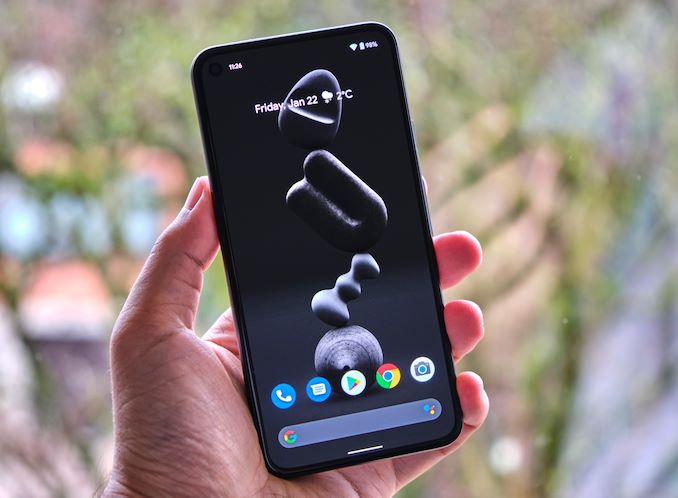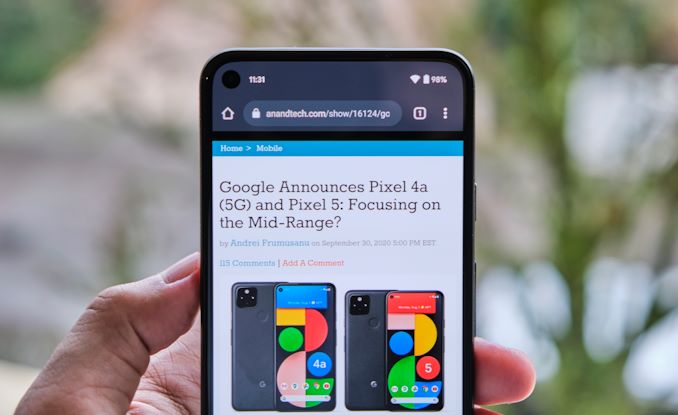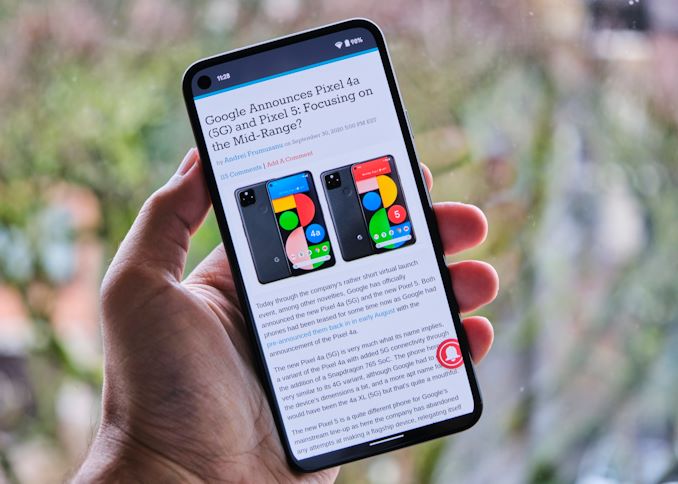The Google Pixel 5: A Mini-Review - Small Package, Small Value?
by Andrei Frumusanu on January 22, 2021 9:00 AM EST- Posted in
- Smartphones
- Mobile
- Pixel 5

It’s been a couple of months now since Google announced the Pixel 5 – Unfortunately we didn’t quite get to a timely review of the device due to other important industry coverage. Today I wanted to revisit the phone in a briefer format review, revisiting some important aspects of the phone such as performance, battery life, and add a few comments about the camera capabilities.
The Pixel 5 is a change of tactic for Google, with the company opting to go the route of a lower-cost “premium” or high mid-range component configuration, rather than setting up the Pixel 5 as an all-out flagship phone. Given the company’s product release cadence over the years, always releasing new phones towards the end of the year, just around the corner of the spring next-gen releases. This schedule had always been a disadvantage for Pixel flagships, so maybe Google’s change of strategy here to go for the mid-range is a more sensible approach.
| 2020 Google Pixels | ||||
| Pixel 4a | Pixel 4a (5G) | Pixel 5 | ||
| SoC | Snapdragon 730G 2x CA76 @ 2.2GHz 6x CA55 @ 1.8GHz Adreno 618 |
Snapdragon 765G 1x CA76 @ 2.4GHz 1x CA76 @ 2.2GHz 6x CA55 @ 1.8GHz Adreno 620 |
||
| DRAM | 6GB LPDDR4X | 8GB LPDDR4X | ||
| Storage | 128GB UFS 2.1 | 128GB | 128GB | |
| Display | 5.81" OLED 2340 x 1080 (19.5:9) |
6.2" OLED 2340 x 1080 (19.5:9) |
6.0" OLED 2340 x 1080 (19.5:9) 90Hz |
|
| Size | Height | 144.0 mm | 153.9 mm | 144.7 mm |
| Width | 69.4 mm | 74.0 mm | 70.4 mm | |
| Depth | 8.2 mm | 8.2 mm | 8.0 mm | |
| Weight | 143 grams | 168g (sub-6) 171g (mmWave) |
151g | |
| Battery Capacity | 3140mAh (typical) 18W Fast Charging |
3885mAh (typical) 18W Fast Charging |
4080mAh (typical) 18W Fast Charging |
|
| Wireless Charging | - | - | Yes | |
| Rear Cameras | ||||
| Main | 12.2MP 1.4µm Dual Pixel PDAF f/1.7 77° lens with OIS |
|||
| Telephoto | - | - | - | |
| Wide | - | 16MP 1.0µm f/2.2 107° Ultra-Wide Angle |
||
| Extra | - | - | - | |
| Front Camera | 8MP 1.12µm f/2.0 84° lens; fixed focus |
|||
| I/O | USB-C 3.5mm headphone jack |
USB-C | ||
| Wireless (local) | 802.11ac Wave 2 Wi-Fi Bluetooth 5.0 LE + NFC |
|||
| Cellular | Snapdragon LTE Integrated X15 (LTE Category 12/5) DL = 600Mbps UL = 150Mbps |
Snapdragon 5G Integrated X52 (LTE Category 18/13) DL = 1200 Mbps UL = 150 Mbps (5G NR Sub-6 + mmWave*) DL = 3700 Mbps UL = 1600 Mbps *excludes non-mmWave model of 4a(5G) *excludes mmWave in non-US markets |
||
| Other Features | Dual Speakers | Dual Speakers | Dual Speakers IP68 Rating |
|
| Dual-SIM | 1x nanoSIM + eSIM | |||
| Launch Price | $349 / 349£ / 349€ |
$499 / £499 / €499 $599* (mmWave) |
$699* / £599 / €629 |
|
Starting off with the SoC, as we’ve discussed it over the last few months, the big difference for the new Pixel 5 is that it comes with a “premium” range Snapdragon 765 chipset from Qualcomm, rather than using the contemporary Snapdragon 865 flagship SoC. This is undoubtedly a cost-cutting measure for Google to be able to achieve this new price point of $699 / €629.
The SoC should still be plenty performance for every-day usages thanks to the two Cortex-A76 big cores, with one of them clocking up to 2.4GHz and the other one at 2.2GHz, however it’s still going to be a notable downgrade compared to the flagship SoCs which employ both newer CPU cores as well as clocking them higher. The SoC’s Adreno 620 GPU is also going to be a key factor in the general performance of the Pixel 5, making some big gaming performance compromises that we’ll cover in more detail in the GPU section.
Google dons the Pixel 5 with 8GB of LPDDR4X memory and a singular storage option of 128GB, without any expandable storage.
The Pixel 5’s front design adopts the similar uniform bezel design introduced with the lower-cost Pixel 4a, and is a departure from the chin and forehead style of the previous generations, also avoiding the usage of odd camera notches. Instead, we have an in-screen camera cut-out in the top left corner, which works quite well. It’s definitely a much more modern design that we’ve seen in previous generation Pixel phones.
The actual display is a 2340 x 1080 OLED screen with a 90Hz refresh rate. This year, I’ve not seen any issues with the display panel as it’s quite high quality even though the specifications aren’t exactly up to par with 1440p 120Hz competitors.
At 6.0” diagonal and only 70.4mm phone width however, the 1080p resolution isn’t an issue as the pixel density is very viable.
The camera setup on the Pixel 5 is quite simple, but Google made some important changes in the secondary module compared to last generation, replacing the dedicated telephoto module with an ultra-wide camera. It’s always possible to pinch-to-zoom to get closer to your subject (although with quality drop), however it’s not possible to pinch out to get a wider field of view if you don’t have the camera hardware for it. This was a large criticism of the previous generation Pixel phones as they had been the only relevant devices in the market not actually using a UWA module. The camera here is a 16MP 1.0µm unit with an f/2.2 aperture and a 107° FoV – not the widest out there, but still plenty competitive and very usable.
The main camera module continues to be a 12.2MP 1.4µm sensor module with f/1.7 optics and OIS – it’s the same module we’ve seen in the Pixel 4 and an overall camera formula we haven’t seen changed in many generations of Pixel phones. Google this year advertised improvements in the HDR algorithms – although you can’t say that the overall camera experience is as ground-breaking as it was a few years ago.
The one regard where the Pixel 5 really differentiates itself from almost any other contemporary phone in the market is its build materials and build-quality. Unlike the usual glass sandwiches of recent years, the Pixel 5 uses an aluminium unibody. It’s not naked aluminium as it has a special plastic coating on it, which gives it a grippy feel, but also isn’t exactly the same as a full plastic phone.
The special thing about the aluminium body is that Google still managed to employ wireless charging though a cut-out in the frame, which of course is invisible to the user due to the plastic coating on top of it.
Generally, I found the design of the Pixel 5 to be pretty good and it had excellent ergonomics. It’s very rare to have good small phones nowadays, and at only 70.4mm width and 151g weight, the Pixel 5 does quite well to address this part of the market. Google opted not to release a Pixel 5 XL this year, so you don’t really have a choice if you prefer a larger variant of the phone – you’d have to go with the Pixel 4a XL, or another competitor device.













104 Comments
View All Comments
shabby - Friday, January 22, 2021 - link
So after looking at the chart it's $200 more for 2gb of ram, 90hz screen, ip68 rating, wireless charging and headphone jack deletion? Go home Google you're drunk.cbm80 - Friday, January 22, 2021 - link
It's a luxury product for people who don't care about price.Operandi - Friday, January 22, 2021 - link
That might be ok if had the look and feel of a high-end phone but its plastic, at least what you touch and feel is. BTW Google if you want wireless charging but want to avoid glass there are all kinds of materials that would work; carbon fiber, Kevlar, wood, maybe even ceramic all of which would look and feel better than plastic.I like what Google tries to do with the Pixel phones but the 5 is pretty disappointing.
MattMe - Friday, January 22, 2021 - link
I bought a Pixel 5 a couple weeks back and have to say I much prefer the feel of this over other glass devices I've used recently. It's contoured nicely, is a good size and the textured resin material feels very firm with a nice textured feel to it. It certainly doesn't feel cheap at all, but it does feel more robust meaning I'm less concerned about it cracking or smashing like many glass-backed devices I've owned.BedfordTim - Friday, January 22, 2021 - link
I will agree, but glass devices are easily fixed with a case.vuvaldi - Friday, January 22, 2021 - link
If you would put a case on the look or feel of the material doesn't matter, and glass is heavier than plastic so plastic wins clearly here.BedfordTim - Monday, January 25, 2021 - link
I fully agree that plastic is a far more sensible material for phones. To me design peaked with the Nokia 735. Unfortunately all the best phones now have a glass back and rather than reject them, there is a partial work around.at_clucks - Friday, January 22, 2021 - link
With a *plastic* case. So just pretend there's glass under the Pixel's and that plastic case, you just never want to take it down and look. Fixed it for you.This whole "glass=premium feel" thing was started by reviewers who ran out of things to write and just bought the hype from manufacturers that glass must be something awesome. On the other hand reading reviews of plastic phones made you think touching them will give you the plague. By the time they figured out how fragile the phone gets most people were already trained that glass=premium and manufacturers were happy to deliver on it.
We ended up having super fragile phones that have to be wrapped in armored cases just to survive. We never see their back once we take them out of the box and slap on the case but deep down inside we live with that warm fuzzy feeling that they're premium underneath.
Plastic is just fine and cheaper. It can be made too feel pleasant and sturdy, certainly more so than glass. Whoever had a Lumia 1020 can confirm just how nice that polycarbonate casing was, no case needed. And plastic is cheaper so you can have a phone that's just as good but lighter and cheaper.
DougMcC - Friday, January 22, 2021 - link
+1000. Gimme unbreakable phone so I don't have to add an extra 25% weight case. I couldn't care less what material it's made of.patel21 - Friday, January 22, 2021 - link
+100kGive me a phone like S7 Active. And no need for even a screen protector.